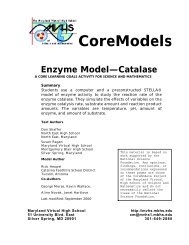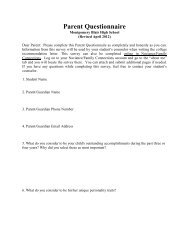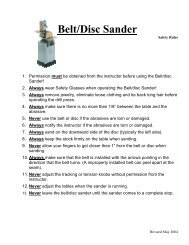The Structure and Function of Enzymes MODULE 1 MODULE 2 ...
The Structure and Function of Enzymes MODULE 1 MODULE 2 ...
The Structure and Function of Enzymes MODULE 1 MODULE 2 ...
Create successful ePaper yourself
Turn your PDF publications into a flip-book with our unique Google optimized e-Paper software.
<strong>The</strong> Effects <strong>of</strong> pH on the <strong>Function</strong> <strong>of</strong> Catalase - Answer KeyObservations:Table 1: Results <strong>of</strong> a study <strong>of</strong> the effects <strong>of</strong> pH on enzyme behavior.Test performed pHTest result(+/-)Additional observationsWater 7 +Bubbles form around the potato.<strong>The</strong> slices float to the surface.Vinegar 2- 3 - No reaction occurs.0.1 M NaOH 13 - No reaction occurs.Detergent 10 – 11 +<strong>The</strong> reaction that occurs is notas vigorous as it is with water.Analysis:1. <strong>Enzymes</strong> are reaction specific. That is, they catalyze a specific chemical reaction.Which lab observations permit you to infer that catalase acted on the hydrogenperoxide <strong>and</strong> not on the other solutions that were used in the lab?Bubbles did not form when the solutions were added. Bubbles formed onlyafter the hydrogen peroxide was added.2. <strong>The</strong> shape <strong>of</strong> a protein <strong>and</strong> its ability to function can be changed by environmentalfactors such as pH <strong>and</strong> temperature. Which laboratory observation permits you toinfer that catalase contains a protein?<strong>The</strong> tests at the extreme pH values (acetic acid <strong>and</strong> sodium hydroxide) producednegative results while the other tests were positive.Application <strong>of</strong> principles1. Placing 3% hydrogen peroxide on a cut produces bubbles. What causes the bubblesto form in the wound, but not on the surrounding skin?<strong>The</strong> damaged cells around the wound release catalase (or some similar enzyme).<strong>The</strong> unbroken skin around the wound does not release catalase.2. Hydrogen peroxide is an effective antiseptic on surfaces but is less effective on a skinwound. Account for this difference.Since catalase is present at the site <strong>of</strong> a skin wound, hydrogen peroxide is beingdecomposed rapidly. Surfaces do not have enzymes <strong>and</strong> so the hydrogenperoxide lasts longer <strong>and</strong> can more effectively kill any bacteria in the area.3. When an apple is cut <strong>and</strong> left out for awhile, the wound turns brown because <strong>of</strong> theaction <strong>of</strong> an enzyme found in the apple cells. Applying lemon juice (pH = 3) preventsthe apple from turning brown. Use the results <strong>of</strong> your laboratory investigation <strong>and</strong>your knowledge <strong>of</strong> enzymes to account for this.Enzyme action is affected by the pH <strong>of</strong> the environment. <strong>The</strong> result <strong>of</strong> the aceticacid test shows that a low pH prevents an enzyme from functioning.30
















